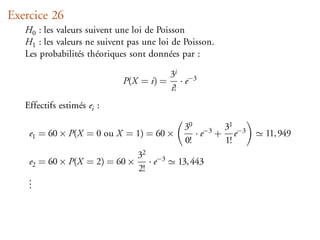Ch35 26
- 1. Exercice 26
H0 : les valeurs suivent une loi de Poisson
H1 : les valeurs ne suivent pas une loi de Poisson.
Les probabilités théoriques sont données par :
3i −3
P(X = i) = ·e
i!
Effectifs estimés ei :
30 −3 31 −3
e1 = 60 × P(X = 0 ou X = 1) = 60 × ·e + e 11, 949
0! 1!
32 −3
e2 = 60 × P(X = 2) = 60 × ·e 13, 443
2!
.
.
.
- 2. Exercice 26 (suite..)
e6 = 60 × P(X ≥ 6) = complément à 60 5, 035
(18 − 11, 949)2 (9 − 5, 035)2
χ2 = + ··· + 9, 264
11, 949 5, 035
Comme aucun paramètre n’a été estimé : d = 6 − 1 = 5
χd,α = χ5,0.05
2 2 11, 07
Comme χ 2 < χd,α , on accepte H0
2
Le nombre de retraits importants suit une loi de Poisson de paramètre
λ=3
